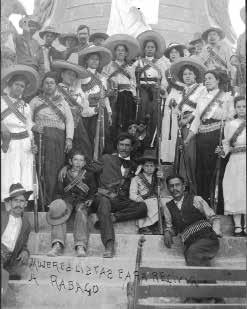
3 minute read
Soldaderas: The Unspoken Heroines of The Mexican Revolution
BY DESTINY TORRES
Today women in the United States and Mexico look to the soldaderas as a symbol of motivation and hope. Her image is a powerful representation of feminine strength and perseverance.
Advertisement
The year is 1910, and the Mexican Revolution is in full force. Men are drafted into the war, and while women are expected to stay behind at home, many decide to follow the men and fight alongside them while also taking the role of caretakers and nurses.

The soldaderas (female soldiers), also known as adelitas due to a ballad popular during the time, cooked, cleaned, carried equipment, and set up campsites for the male soldiers. Adelitas were unrecognized major contributors to the fight to revolutionize Mexico. Thousands of women of all ages, sizes, and social classes joined the fight from all sides of the war. There were many sides to this decade-long war. Some fought for the federPHOTO BY NOVA BLANCO-RICO al side, the rebellious side, Translation of the song “La Adelita” by Antonio Gil del Rio Armenta. and the side that wanted to overthrow the governUNIVERSITY OF TEXAS AT EL PASO LIBRARY SPECIAL COLLECTIONS ment in power at the time. Soldaderas carrying the heavy equipment for their fellow soldiers BY DESTINY TORRES began to gain momentum, Soldaderas could be found during the Mexican Revolution
Flash forward to the Chicano movement of the 1960s; a crusade of ethnic empowerment and protests, like the East Los Angeles Walkouts, and the image of soldaderas and Adelita is just as important.
The Chicano movement of the 1960s was led by passionate men and women striving for change for their people. The women, however, faced endless accounts of machismo, or strong masculine pride, which kept them from flourishing in the movement. As the first wave of the Chicana feminist movement
Soldaderas were reimagined through Chicana activists like Dolores Huerta, Gloria Saldura, and more female activists, who along with fighting for the rights of the Chicanx community, they also were fighting for their right to be treated equally by their male counterparts.
Hérnandez said one of the biggest failures of the movement was that men didn’t recognize equity between men and women.
“The image of the soldadera was absolutely and continues to be a major source of inspiration for women, especially Chicana women,” He said. “But there’s a difference there when you use the term soldadera, and men were seeing them as ‘las adelitas,’ so there’s a gender divide in the understanding of the roles.”
Today women in the United States and Mexico look to the soldaderas as a symbol of motivation and hope. Her image is a powerful representation of feminine strength and perseverance.
Photo by George Rodriguez

Hilda Reyes Jensen, a 16-year-old Brown Beret, who helped in the organization of the Chicano Moratorium March

The soldaderas (female soldiers), also known as adelitas due to a ballad popular during the time, cooked, cleaned, carried equipment, and set up campsites for the male soldiers.
Adelitas were unrecognized major contributors to the fight to revolutionize Mexico.

In the late 1960s, a Chicano organization emerged called The Brown Berets. The organization focused on farmer workers’ rights, police brutality and anti-war presentations. The group began to lose strength when women involved grew tired of being left out of larger jobs.
“The image of the soldadera was absolutely and continues to be a major source of inspiration for women, especially Chicana women,” He said. “But there’s a difference there when you use the term soldadera, and men were seeing them as ‘las adelitas,’ so there’s a gender divide in the understanding of the roles.”
Soldaderas were reimagined through Chicana activists like Dolores Huerta, Gloria Saldura, and more female activists, who along with fighting for the rights of the Chicanx community, they also were fighting for their right to be treated equally by their male counterparts.
Staff Reporter

